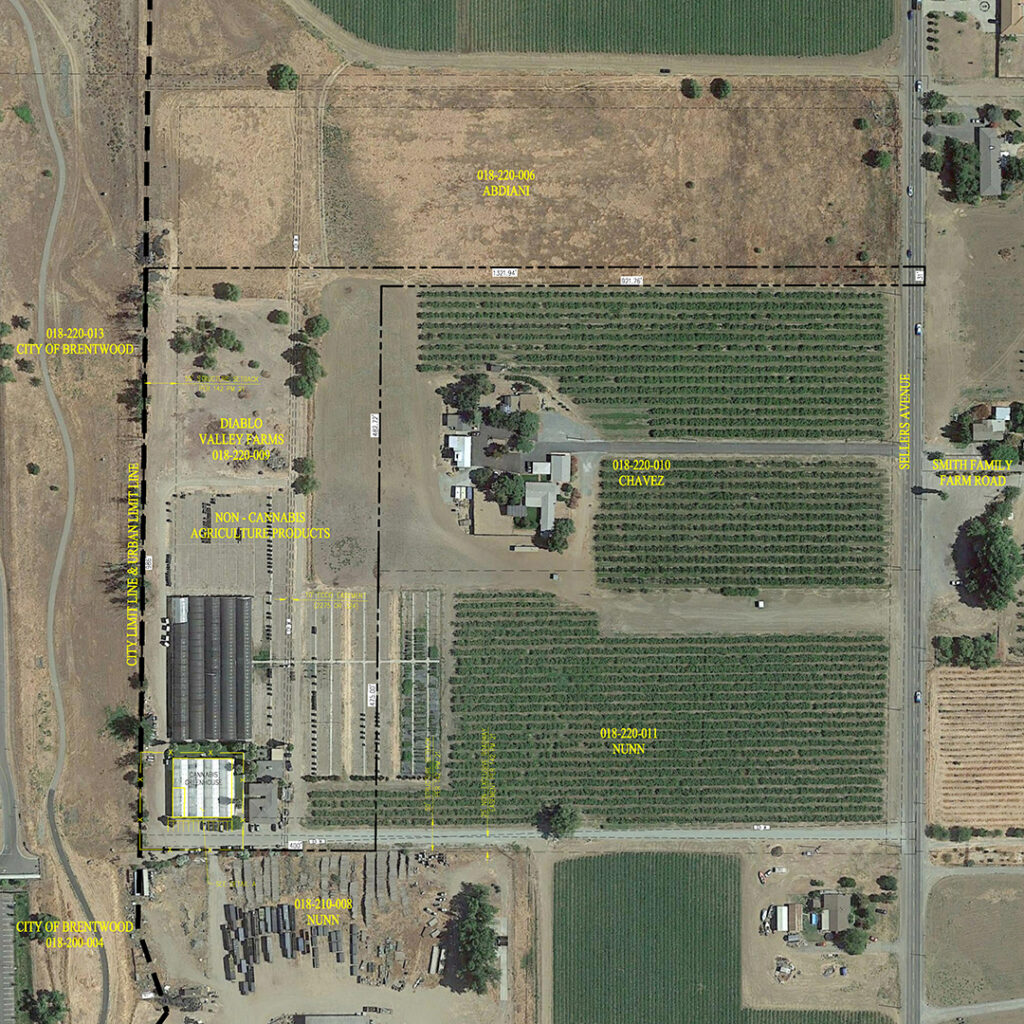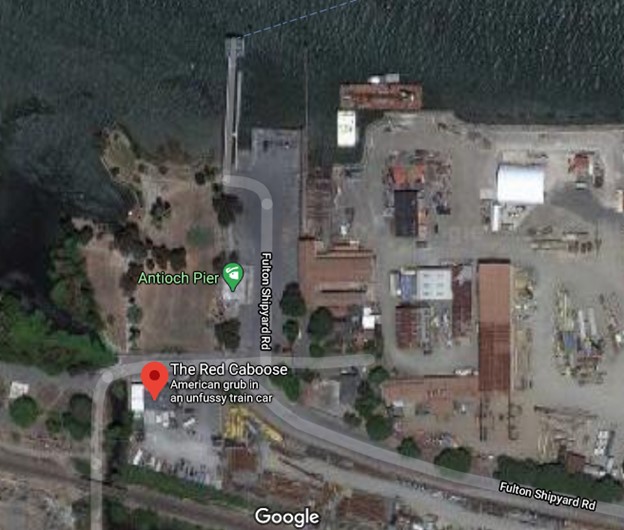Supervisors reverse Planning Commission decision on East Contra Costa cannabis micro plant farm
Thursday, March 25th, 2021
Diablo Valley Farms indoor cannabis cultivation site plan.
Bay Point Pedestrian and Bicycle Improvement Project moves forward
Honor Deer Valley High student, other winners of annual Poetry Out Loud competition

Closeup view of greenhouses.
By Daniel Borsuk
The Contra Costa County Board of Supervisors voted 5-0 to permit longtime Brentwood grower Bob Nunn and land planner Lisa Borba, who also serves as a Contra Costa Water District commissioner, to proceed and develop two 10,000 square foot indoor cannabis cultivation greenhouses at 4425 Sellers Avenue over the objections of residents. DVF Business Proposal
According to the conditions of approval for the project, the use “permit is for the commercial cultivation of cannabis micro plants only” and “no mature cannabis plants are permitted on the site at any time.” DVF Findings & Modified COAs 03152021
The supervisors’ action reverses a January 27th county planning commission decision that had negated an earlier approval of the proposed cannabis development in Eastern Contra Costa County that had proposed only one 10,000 square foot greenhouse.
During the hearing, supervisors listened to six unidentified speakers oppose the proposed Diablo Valley Farms project on grounds it is nearby a youth center and it will breed crime, noise and odor problems into the environment.
In a Feb. 8th letter from attorney Shawn J. Zovod, the developers Robert Nunn and Borba, and addressed to Contra Costa County Planner Joseph Lawlor, Zovod wrote: DVF SZovod Appeal Letter 02082021 SZovod 030521 Letter to JLawlor Project Planner
“The owner of DVF, Robert Nunn, and the applicant, Lisa Borba (collectively “Applicant”) appeals the CPC decision on the following grounds:
- The CPC decision to deny the Permit was based on an erroneous finding that Sunset Park is a “youth center.” This finding is not supported by the evidence and provides grounds for appeal under Code Section 26-2.2404c (3) Sunset Park is a park and is not a youth center within the meaning of the Cannabis Regulation and Section 11353.1 of the California Health and Safety Code…The CPC’s finding that Sunset Park is a “youth center” and thereby a Protected Use is not satisfied by evidence and is a gross misinterpretation of the Cannabis Regulation.
- “…. Denial of the permit based on an inaccurate and inconsistently applied reading of the requirements of the Cannabis Regulation is denial of equal protection. The CBO cannot turn its back on the laws that it adopted after years of careful consideration. Appellant has invested significant time and tens of thousands of dollars in reliance on the county’s application of its standards on a fair and equitable basis.
Appellant requests the Board of Supervisors uphold this appeal of the CPS, reinstate the Permit as approved by the Zoning Administrator, and decline to add any additional conditions requested by the City of Brentwood to the Permit.”
While supervisors heard from six unidentified Brentwood residents about concerns that the proposed Diablo Valley Farms project will produce crime, odor and noise, Brentwood Police Chief Tom Hansen said the proposed development will bring more “serious crime” to the city and his “officers will be in grave danger.” The police chief recommended that supervisors keep the county planning commission’s January decision intact.
Board Chair Diane Burgis of Brentwood turned the table when she recommended that supervisors reverse the county planning commission’s January action and to approve the Nunn/Borba project.
“They have made it clear there will be no plants of value,” said Burgis. “There will be security. There will be no cash on site. The permit will be valid for five years.”
Supervisors approved the permit on a 5-0 vote.

Approve Engineering Contract for Bay Point Pedestrian and Bicycle Improvement Project
Supervisors approved a $590,000 contract with MNS Engineers, Inc. to provide consulting services with the county Public Works Department for construction management services for the Bailey Road/State Route 4 Interchange Pedestrian and Bicycle Improvement Project for the period March 23, 2021 to June 30, 2022 in the Bay Point area.
The project consists of constructing a retaining wall, widening the State Route 4 westbound diagonal off-ramp, installation and modification of traffic signals, removal of the SR4 westbound loop off-ramp, storm drain modifications, and installation of sidewalk along Bailey Road.
Funding for the project is from the Active Transportation Program (ATP), Bay Point Area of Benefit, Navy Mitigation Funds, Contra Costa County Measure J transportation half-cent sales tax, and the state gas tax.
Recognize 2021 Poetry Out Loud Winners
 Supervisors passed a resolution honoring Pinole Valley High School Senior Jermaine Gitana who won first place honors in the Contra Costa County Poetry Out Loud 2021 Competition. Gitana topped second place winner Esmeralda Noyola, a junior at Antioch’s Deer Valley High School, and third place winner Tessa Brubaker, a junior at San Ramon High School in Danville. (See related article)
Supervisors passed a resolution honoring Pinole Valley High School Senior Jermaine Gitana who won first place honors in the Contra Costa County Poetry Out Loud 2021 Competition. Gitana topped second place winner Esmeralda Noyola, a junior at Antioch’s Deer Valley High School, and third place winner Tessa Brubaker, a junior at San Ramon High School in Danville. (See related article)
Initiated by the National Endowment for the Arts and run by the California Arts Council in the state and locally by the Arts and Culture Commission of Contra Costa County, the program, now in its 14th year, engages high school students in the presentation of poetry through memorization and performance.
Almost 1,000 viewers watched the students’ recitations that were viewed at the Virtual Screening and Awards Ceremony Facebook Live event.
Recognize Melody Hung-Fan and Eric Moe for Years of County Service
Supervisors passed two resolutions recognizing the years of service for Melody Hung-Fan, director of the Contra Costa County Public Health Laboratory, and Eric H. Moe, a 35-year Contra Costa County Treasurer-Tax Collector’s Office expert in automation and streamlining workflow of default-tax procedures.
Ms. Hung started her career at CCCPH in 1988 as a public health microbiologist and rose through the ranks to become director of the Public Health Laboratory in January 2013 where she has spent the last eight years planning, evaluating, organizing, and directing all activities and staff of the CCCPH.
She became a licensed Public Health Microbiologist (PHM) through the California Department of Public Health in July of 1988 after receiving a Bachelor of Science in Nutritional Services and a Master of Public Health, both from the University of California at Berkeley.
Ms. Hung has been recognized for her background in research through the publication of various abstracts and journal articles, the most recent including articles published by the American Society for Microbiology, entitled: “A Population-Based Surveillance Study of Shared Genotypes of Escherichia coli Isolates from Retail Meat and Suspected Cases of Urinary Tract Infections.”
Her work has been credited in all phases of creating, running, and evaluating testing procedures for a variety of public health issues including HIV, West Nile virus, Zika virus, Influenza, SARS-CoV-2 and other diseases.
Moe is retiring from a long career in the Treasurer-Tax Collector’s Officer where he became an expert in defaulted=tax collections, bankruptcy claims, and the annual sale of properties subject to the Tax Collectors Power to Sell. He began his career with the county in 1986 as a Clerk-Beginner. He rose up the ranks and his major accomplishment include automating and streamlining workflow of default-tax procedures to more accurately and expeditiously address and manage the many accounts that transfer to the Redemption or delinquent Secured tax roll annually, and the documenting and re-organizing of standard operating procedures of the tax-default program into a comprehensive electronic manual. Moe has also been helpful in assisting the California State Controller’s Office with review and feedback to the “Annual Pre-Notice Guide”, the “Review and Taxation Code,” and “The County Tax Collectors’ Reference Manual.”
County Awards Contract to Labor Attorney Kramer
Supervisors awarded a contract with labor attorney Karen Kramer, who is not related to Contra Costa County Assessor Gus Kramer, for workplace investigation and workplace legal advice. Ms. Kramer specializes in employment law and litigation. She will be of assistance to the County Counsel in the county’s workplace investigations.
Kramer Workplace Investigations will bill the county at an hourly rate of $325 for legal and investigatory services and $400 per hour for testimony.
She is not related to Assessor Kramer, who last November had misconduct charges dropped against him by Superior Court Judge John Cope for accusations of making sexual comments to employees and at least one ethnic slur to a co-worker.
Approve Property Cleanup Cases in Oakley, Martinez and El Sobrante
Supervisors approved three abatement cases. No public speakers were heard on the cases.
The biggest case totaling $38,056.20 was charged to the owners of 2600 Dutch Slough Road in Oakley. The residential property is jointly owned by Darlene Joy Gargulia, Nguyen Ha and Long Hoang Le.
Another residential abatement action costing $4,306.70 occurred at 5321 Alhambra Valley Road in Martinez. The property is owned by Carol M. Gainey.
Supervisors approved abatement action totaling $4,296.70 at 3870 Valley Lane in El Sobrante. Greg Fremont Livermore is owner of the property.
























